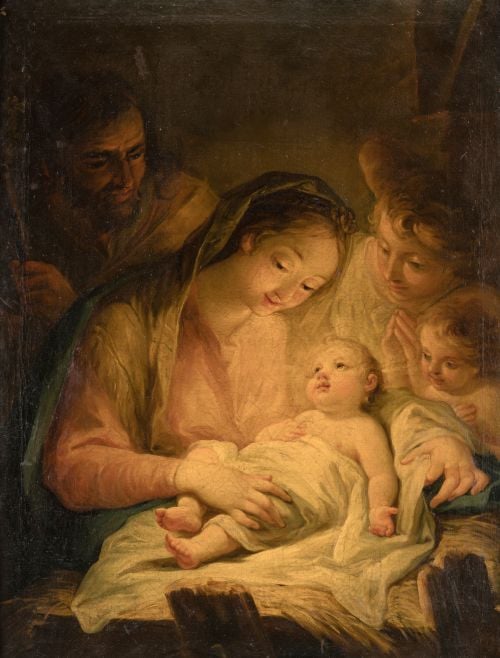Lot 138
(1739 / 1819)
MARIANO SALVADOR MAELLA Valencia (1739) / Madrid (1819) "Nativity of Christ", 1805-1806
Oil on canvas. Provenance: Ducal House of Hijar, possible commission to the painter by Pedro de Alcantara de Silva, 9th Duke of Hijar; Ducal House of Hijar (throughout the 19th century); Maria Araceli de Silva y Fernandez de Cordoba, 11th Duchess of Almazan (from 1930); Seized during the Spanish Civil War and deposited in the Museo Nacional del Prado (1936-1939); Maria del Rosario Mariategui y Silva, 12th Duchess of Almazan (until 2008); From there by succession to its current owners. Bibliography: Delegate Board for the Seizure, Protection and Rescue of Artistic Treasures, collection inventory number: Almazan 15, deposit number at the Museo del Prado: 8097; English: Photo library of the Institute of Cultural Heritage of Spain. Moreno Archive (15262_B); Study of the work carried out by Professor Dr. Arturo Anson Navarro, dated October 7, 2014. Reference bibliography: DE LA MANO, J., Mariano Salvador Maella. Power and image in the Spain of the Enlightenment, Madrid, 2011. The Valencian Mariano Salvador Maella is considered one of the best Spanish painters of the 18th century. Chamber painter of Charles III, he devoted himself mainly to the decoration of the Royal Palace of Madrid and other Royal Sites; the decoration of important cathedrals such as those of Valencia, Toledo, Burgo de Osma or Jaen, and some commissions for the main houses of the Spanish aristocracy; a good example being the work presented here representing the Nativity of Christ. This beautiful and harmonious painting, as Arturo Anson points out in the extensive study he made of it, was commissioned by Don Pedro de Alcantara de Silva, 9th Duke of Hijar, possibly intended for the bedroom or a small oratory of his palatial residence. Stylistically, this Nativity of Maella is closely related to the large painting of the Adoration of the Shepherds (DE LA MANO, J., 2011, V.71 and V.72, early 476-477) that the Valencian painter made in 1806 for the chapel of the new Madrid palace that the Dukes of Villahermosa had ordered to be built on the Paseo del Prado. As Arturo Anson points out, the work must have been painted at a similar date, since both reflect the painter's mature style and are very similar compositionally, although there are variations in the position of some figures. The painting shows the characters in the middle of a nocturnal environment, showing the Virgin smiling at the Child Jesus and kneeling in front of the manger, displaying a gesture of complacency. The Child Jesus radiates the light that illuminates the scene and, with the position of his hands, seems to want to communicate to his parents the knowledge and acceptance of his redemptive mission. As Anson indicates, the painting is a good example of the enlightened Catholic sensibility that combines religious emotion with delicacy and expressive restraint; a religiosity that is more interior than exterior,of neo-Erasmian theological foundations, which is expressed through an intimate and austere devotion. Attached is a study of the painting carried out by Professor Don Arturo Anson Navarro on October 7, 2014. Measurements: 97 x 73 cm.
Starting price 20.000 €
Recomended lots
Confirm
You are bidding €
At the time of auction we will contact you by phone:
You accept the conditions of the room by confirming your bid
Loading…
Conecting with the server
Are you sure you want to buy the lot?

